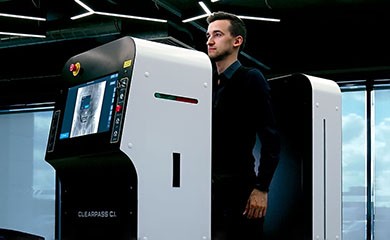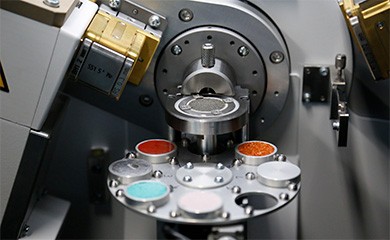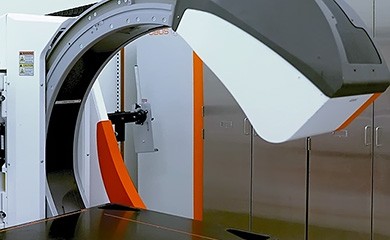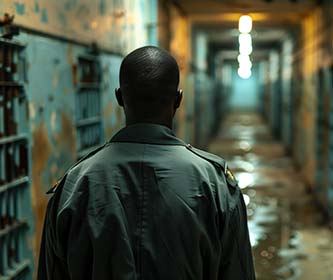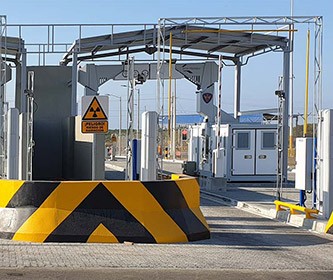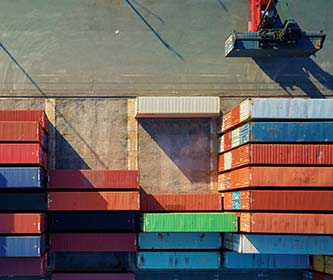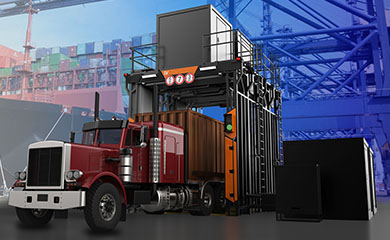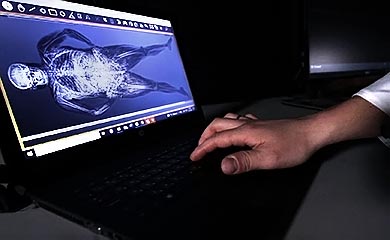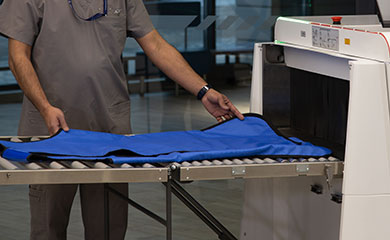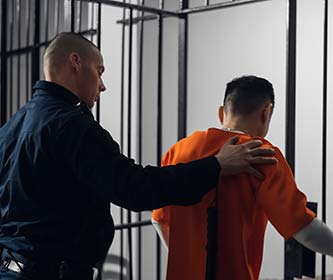

15 October 2025
From Open Campus to Smart Campus: Modernizing Bag Screening Without Slowing Student Life
At Linev Systems®, we work directly with facilities staff, campus police, and college administration. Student unions at lunch rush hour, keeping an eye on traffic at library doors after midnight, and charting the routes between residence halls and stadiums. In 2025, it is evident that American colleges must continue to be accessible, friendly, and dynamic while still being capable of discreetly handling changing safety threats like illegal narcotics and firearms. The most common questions we receive from administrators are straightforward: how can we improve security without making the college an airport? Design, data, and the appropriate technological stack, especially contemporary X-ray imaging technologies that see more while occupying less space, are the keys to the solution. Because of this, X-ray security solutions for colleges are now a campus-wide capability that protects people and maintains the academic experience, rather than a “nice to have” piece of equipment for colleges.
The new risk profile of an open campus
Campus activity patterns have changed in recent years. Student centres can be used for events. During exam periods, libraries are open almost twenty-four hours a day. Volumes received by package rooms are comparable to those of small business centres. Student organizations, on the other hand, organize pop-up events that need to be quickly and temporarily screened without weeks of preparation. Conventional methods such as walk-through metal detectors or random bag inspections are insufficient, particularly when it comes to non-metal weaponry or drug contraband hidden in cluttered backpacks. Administrators understand that they require X-ray security solutions for colleges that can adjust to various buildings and traffic volumes, take pictures for compliance and training, and interface with the digital incident reporting systems that campus police use.
Throughput without friction
It makes sense to worry that screening will make life more difficult for students. But it doesn’t have to be that way, as demonstrated by our baggage X-ray scanners. Flow engineering is more important than hardware location. Students can put a backpack on the belt and continue to move thanks to small, high-throughput scanners placed at natural congestion points, such as student union entry lanes. Clear sightlines and student-ambassador staffing foster a collaborative atmosphere that feels more like a normal stop on the way to class than like enforcement. In order to maintain belts moving at a speed that corresponds with peak demand, modern conveyors and image processing minimize rescans. Lane layouts that can expand from a single scanner to three parallel lanes during events are created by modelling arrival patterns by time of day while designing a deployment. In actuality, everyone has a better experience and the entrance is quicker than with manual checks.
Seeing beyond metal to detect weapons
Metal detection alone is not sufficient to address the security risks that colleges face. Items such as three-dimensionally printed parts, ceramic blades, polymer frames, and concealed objects that are missed going through a metal detector are visible under X-ray. While high-resolution photography makes shapes like barrels, slides, magazines, and blade edges visible even when hidden by clothing or books, material discrimination modes differentiate between organic, inorganic, and mixed materials to provide operators with an instant impression of the object type. In addition to increasing detection accuracy for both metal and non-metal weapons, this multi-layered strategy, walk-through detectors combined with X-ray security systems for colleges, reduces invasive bag-by-bag searches that irritate students.
Drug interdiction that respects student privacy
Universities face legal, health, and academic threats as a result of illegal drug use. Manual checks are erratic and have the potential to intensify conflicts with students. By exposing dense packages, taped bundles, powder vials, vapes customized for THC oils, and false bottoms in bags or shipments, imaging helps eliminate guesswork. Operators use X-rays to assess goods rather than people, and when contraband is discovered, the images are safely preserved for compliance and proof. Campuses are better able to manage student privacy and community safety when they have clear procedures that screen for prohibited objects rather than personal belongings. X-ray security systems for colleges enable a health-first approach while adhering to school codes of conduct when paired with amnesty bins and diversion programs.
Quiet technology for quiet spaces
Focus-oriented environments are ideal for student life. Study spaces and libraries cannot put up with intrusive, noisy technology. With remote operator stations that enable picture inspection in a nearby room, our X-ray scanners are small and silent. Operators can use covert headsets to communicate with the lane and only exit when a bag has to be inspected. By doing this, disturbances are reduced and the atmosphere of academic settings is maintained. Mobile units on lockable casters can be stowed when not in use and wheeled into place during periods of high traffic for buildings with strict architectural or historic restrictions. Facilities managers can achieve safety goals with these designs without sacrificing aesthetics or requiring permanent construction.
Data for training, compliance, and continuous improvement
Colleges are accountable to federal guidelines on campus safety, state regulations, and internal standards. One of the benefits of X-ray security technologies for colleges is the data they produce. Security teams can conduct post-event evaluations, assist with investigations, and create operator training libraries customized to the campus risk profile, including drug concealment scenarios and weapon recognition modules, thanks to encrypted image archives. Analytics dashboards that provide operator performance indicators, alert rates, and throughput by hour assist administrators in balancing staffing and assessing the effects of policy changes. Having a database of actual photos and scenarios makes preparation drills conducted by campus police departments under the Clery Act framework more realistic and less theoretical.
Mailrooms and parcel hubs as critical control points
The mailroom is the back entrance to campus life, if the student union is the front. The increase in goods, which range from electronics and textbooks to sports equipment and private belongings, results in a heavy volume of boxes and padded envelopes that can be used to hide drugs or weaponry. In this case, X-ray security solutions for colleges offer two important advantages: anomaly detection, which highlights dense clusters, voids, or abnormal forms for further examination, and quick, conveyor-friendly screening, which keeps packages moving. Images can be linked to student IDs through integration with barcode systems, facilitating a clear chain of possession and quick cooperation with campus police when necessary. A significant security gap is closed when parcel screening is integrated into the same procedure as bag screening.
Event mode for stadiums and pop‑ups
Commencement, game day, concerts, and career fairs are all occasions when thousands of people gather on college campuses. The security posture needs to adapt to these occasions without requiring year-round airport-style checks. Temporary lane kits with mobile scanners, pre-binning tables, and canopy signage keep lines moving while giving attendees a familiar flow. Although secondary gates can function with smaller units, stadiums benefit from larger tunnel systems that can hold team duffels and media equipment. A supervisory operator can support several stations by sharing images across lanes, improving quality without adding more staff. After the event, buildings regain their typical open feel and equipment is put back into storage.
Accessibility and student experience at the checkpoint
When security upholds the dignity of those it protects, that is when it’s at its best. Students who are carrying medically necessary goods or using mobility devices can move around with little difficulty thanks to ADA-aware layouts, flexible work surfaces, and clear visual clues. Maintaining uniform policies across buildings lowers the possibility of inconsistent enforcement and helps to prevent confusion. By design, our technologies protect privacy by analyzing objects in bags rather than persons and securely storing photographs with role-based permissions. These program decisions enhance voluntary compliance and foster trust when well communicated.
Sustainability and total cost of ownership
Colleges continue to prioritize sustainability, and technological choices play a role in that. Service visits and power usage are decreased by energy-efficient electronics, standby modes, and remote diagnostics. Maintenance is predictable due to modular components and a high mean time between failures. Proactive screening is becoming more and more advantageous from a security perspective. The expense of a single evacuation, building closure, or high-profile event is significantly higher than what a properly-sized program would cost. Leaders in higher education are choosing stewardship and safety, together with Linev System®’s X-ray security solutions for colleges.
Implementation playbook for 2025
Campuses that are successful in modernization have a common strategy. They begin by mapping entrances, traffic patterns, and risks in mailrooms, residential halls, libraries, and student unions as part of a site assessment. Before expanding to parcel hubs and high-traffic facilities, they phase deployments to demonstrate value in one or two buildings. To keep skills sharp, they conduct quarterly drills and standardize operator training using a shared image collection that emphasizes drug hiding patterns and weapon recognition. In order to turn a reported bag into a case with timestamps, photos, and results in the campus police system, they incorporate incident reporting. Clear signs and messaging that present screening as a typical aspect of a secure, open campus help to keep students informed. The technological foundation remains constant throughout: quick, small, networked, and capable of ongoing development, X-ray security solutions for colleges.
Looking ahead
The security approach must adapt to the ongoing changes in campus life. Hardening colleges into closed fortresses is not the aim. The goal is to make them more intelligent so they can accept the world while discreetly handling the threats posed by drugs and weapons. Every day at Linev Systems®, we strive to create that balance. Campuses that combine human judgment with intelligent imagery, and that view security as an asset rather than a hindrance to student life, are, in our opinion, the ones of the future. We can assist your college in assessing choices, modelling throughput, and integrating technology into your particular setting. Contact us to request more information or a live demonstration.
The new risk profile of an open campus
Campus activity patterns have changed in recent years. Student centres can be used for events. During exam periods, libraries are open almost twenty-four hours a day. Volumes received by package rooms are comparable to those of small business centres. Student organizations, on the other hand, organize pop-up events that need to be quickly and temporarily screened without weeks of preparation. Conventional methods such as walk-through metal detectors or random bag inspections are insufficient, particularly when it comes to non-metal weaponry or drug contraband hidden in cluttered backpacks. Administrators understand that they require X-ray security solutions for colleges that can adjust to various buildings and traffic volumes, take pictures for compliance and training, and interface with the digital incident reporting systems that campus police use.
Throughput without friction
It makes sense to worry that screening will make life more difficult for students. But it doesn’t have to be that way, as demonstrated by our baggage X-ray scanners. Flow engineering is more important than hardware location. Students can put a backpack on the belt and continue to move thanks to small, high-throughput scanners placed at natural congestion points, such as student union entry lanes. Clear sightlines and student-ambassador staffing foster a collaborative atmosphere that feels more like a normal stop on the way to class than like enforcement. In order to maintain belts moving at a speed that corresponds with peak demand, modern conveyors and image processing minimize rescans. Lane layouts that can expand from a single scanner to three parallel lanes during events are created by modelling arrival patterns by time of day while designing a deployment. In actuality, everyone has a better experience and the entrance is quicker than with manual checks.
Seeing beyond metal to detect weapons
Metal detection alone is not sufficient to address the security risks that colleges face. Items such as three-dimensionally printed parts, ceramic blades, polymer frames, and concealed objects that are missed going through a metal detector are visible under X-ray. While high-resolution photography makes shapes like barrels, slides, magazines, and blade edges visible even when hidden by clothing or books, material discrimination modes differentiate between organic, inorganic, and mixed materials to provide operators with an instant impression of the object type. In addition to increasing detection accuracy for both metal and non-metal weapons, this multi-layered strategy, walk-through detectors combined with X-ray security systems for colleges, reduces invasive bag-by-bag searches that irritate students.
Drug interdiction that respects student privacy
Universities face legal, health, and academic threats as a result of illegal drug use. Manual checks are erratic and have the potential to intensify conflicts with students. By exposing dense packages, taped bundles, powder vials, vapes customized for THC oils, and false bottoms in bags or shipments, imaging helps eliminate guesswork. Operators use X-rays to assess goods rather than people, and when contraband is discovered, the images are safely preserved for compliance and proof. Campuses are better able to manage student privacy and community safety when they have clear procedures that screen for prohibited objects rather than personal belongings. X-ray security systems for colleges enable a health-first approach while adhering to school codes of conduct when paired with amnesty bins and diversion programs.
Quiet technology for quiet spaces
Focus-oriented environments are ideal for student life. Study spaces and libraries cannot put up with intrusive, noisy technology. With remote operator stations that enable picture inspection in a nearby room, our X-ray scanners are small and silent. Operators can use covert headsets to communicate with the lane and only exit when a bag has to be inspected. By doing this, disturbances are reduced and the atmosphere of academic settings is maintained. Mobile units on lockable casters can be stowed when not in use and wheeled into place during periods of high traffic for buildings with strict architectural or historic restrictions. Facilities managers can achieve safety goals with these designs without sacrificing aesthetics or requiring permanent construction.
Data for training, compliance, and continuous improvement
Colleges are accountable to federal guidelines on campus safety, state regulations, and internal standards. One of the benefits of X-ray security technologies for colleges is the data they produce. Security teams can conduct post-event evaluations, assist with investigations, and create operator training libraries customized to the campus risk profile, including drug concealment scenarios and weapon recognition modules, thanks to encrypted image archives. Analytics dashboards that provide operator performance indicators, alert rates, and throughput by hour assist administrators in balancing staffing and assessing the effects of policy changes. Having a database of actual photos and scenarios makes preparation drills conducted by campus police departments under the Clery Act framework more realistic and less theoretical.
Mailrooms and parcel hubs as critical control points
The mailroom is the back entrance to campus life, if the student union is the front. The increase in goods, which range from electronics and textbooks to sports equipment and private belongings, results in a heavy volume of boxes and padded envelopes that can be used to hide drugs or weaponry. In this case, X-ray security solutions for colleges offer two important advantages: anomaly detection, which highlights dense clusters, voids, or abnormal forms for further examination, and quick, conveyor-friendly screening, which keeps packages moving. Images can be linked to student IDs through integration with barcode systems, facilitating a clear chain of possession and quick cooperation with campus police when necessary. A significant security gap is closed when parcel screening is integrated into the same procedure as bag screening.
Event mode for stadiums and pop‑ups
Commencement, game day, concerts, and career fairs are all occasions when thousands of people gather on college campuses. The security posture needs to adapt to these occasions without requiring year-round airport-style checks. Temporary lane kits with mobile scanners, pre-binning tables, and canopy signage keep lines moving while giving attendees a familiar flow. Although secondary gates can function with smaller units, stadiums benefit from larger tunnel systems that can hold team duffels and media equipment. A supervisory operator can support several stations by sharing images across lanes, improving quality without adding more staff. After the event, buildings regain their typical open feel and equipment is put back into storage.
Accessibility and student experience at the checkpoint
When security upholds the dignity of those it protects, that is when it’s at its best. Students who are carrying medically necessary goods or using mobility devices can move around with little difficulty thanks to ADA-aware layouts, flexible work surfaces, and clear visual clues. Maintaining uniform policies across buildings lowers the possibility of inconsistent enforcement and helps to prevent confusion. By design, our technologies protect privacy by analyzing objects in bags rather than persons and securely storing photographs with role-based permissions. These program decisions enhance voluntary compliance and foster trust when well communicated.
Sustainability and total cost of ownership
Colleges continue to prioritize sustainability, and technological choices play a role in that. Service visits and power usage are decreased by energy-efficient electronics, standby modes, and remote diagnostics. Maintenance is predictable due to modular components and a high mean time between failures. Proactive screening is becoming more and more advantageous from a security perspective. The expense of a single evacuation, building closure, or high-profile event is significantly higher than what a properly-sized program would cost. Leaders in higher education are choosing stewardship and safety, together with Linev System®’s X-ray security solutions for colleges.
Implementation playbook for 2025
Campuses that are successful in modernization have a common strategy. They begin by mapping entrances, traffic patterns, and risks in mailrooms, residential halls, libraries, and student unions as part of a site assessment. Before expanding to parcel hubs and high-traffic facilities, they phase deployments to demonstrate value in one or two buildings. To keep skills sharp, they conduct quarterly drills and standardize operator training using a shared image collection that emphasizes drug hiding patterns and weapon recognition. In order to turn a reported bag into a case with timestamps, photos, and results in the campus police system, they incorporate incident reporting. Clear signs and messaging that present screening as a typical aspect of a secure, open campus help to keep students informed. The technological foundation remains constant throughout: quick, small, networked, and capable of ongoing development, X-ray security solutions for colleges.
Looking ahead
The security approach must adapt to the ongoing changes in campus life. Hardening colleges into closed fortresses is not the aim. The goal is to make them more intelligent so they can accept the world while discreetly handling the threats posed by drugs and weapons. Every day at Linev Systems®, we strive to create that balance. Campuses that combine human judgment with intelligent imagery, and that view security as an asset rather than a hindrance to student life, are, in our opinion, the ones of the future. We can assist your college in assessing choices, modelling throughput, and integrating technology into your particular setting. Contact us to request more information or a live demonstration.
